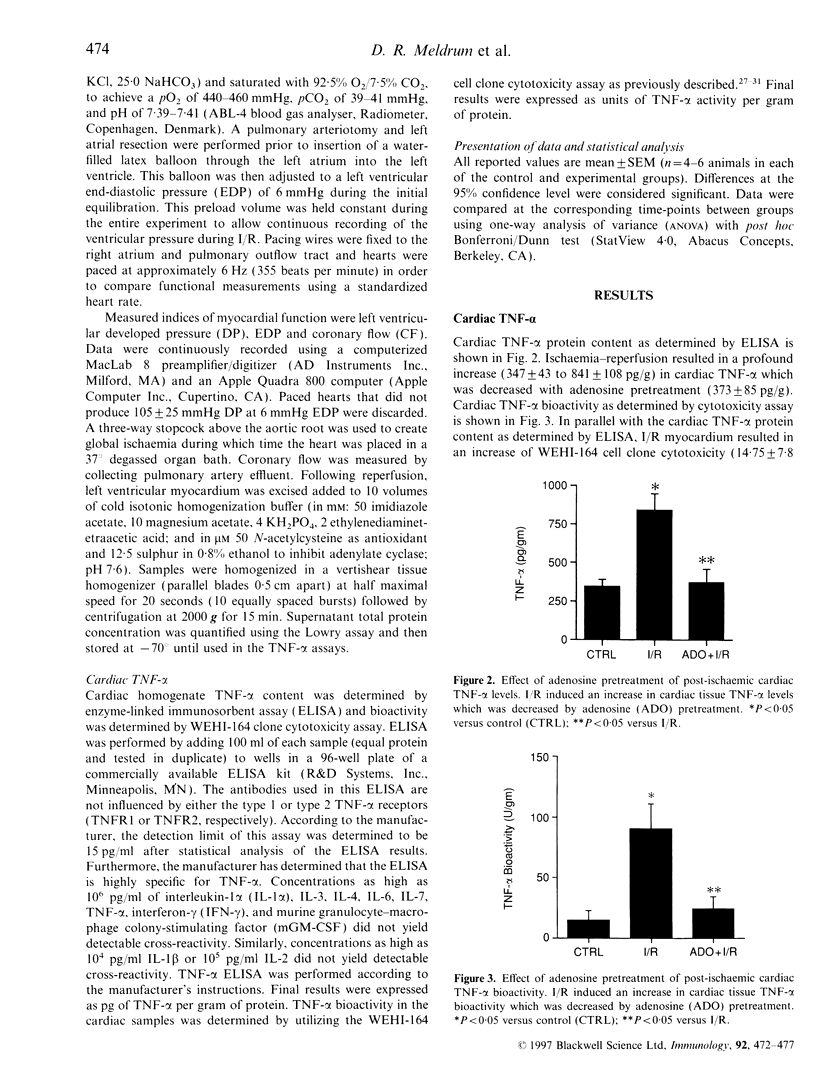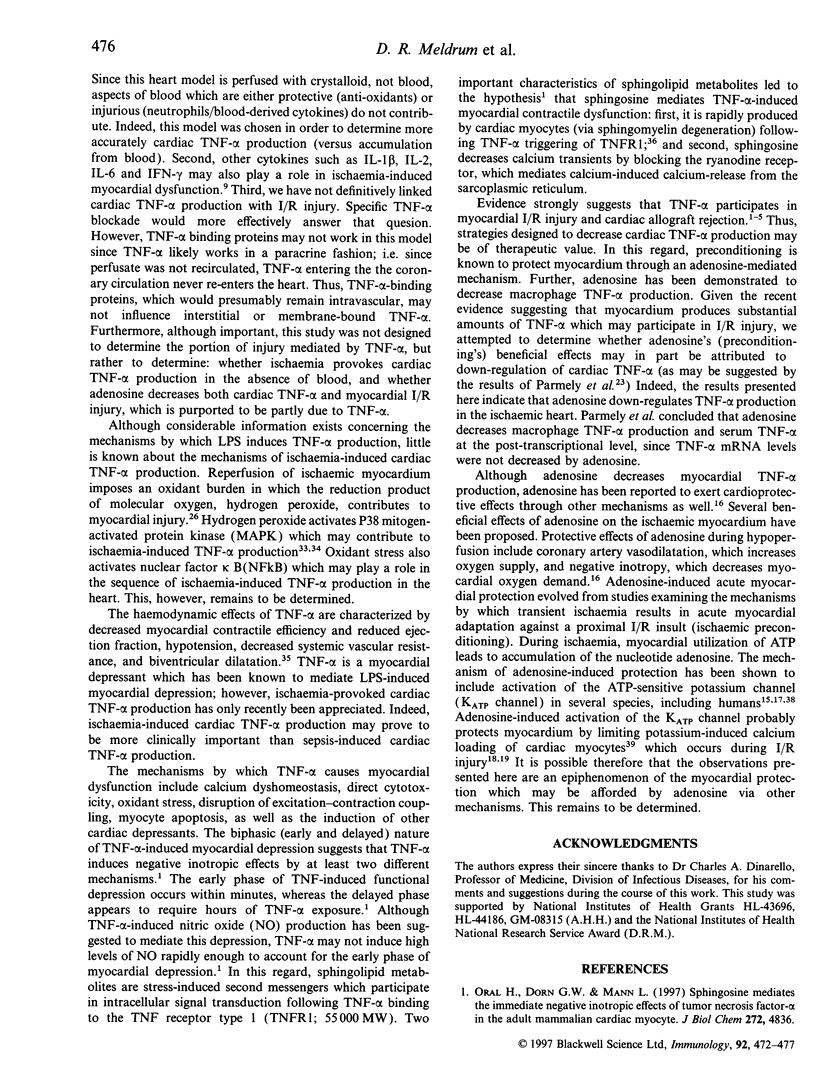Abstract
Tumour necrosis factor-alpha (TNF-alpha) is an autocrine contributor to myocardial dysfunction and cardiomyocyte death in ischaemia-reperfusion injury (I/R), sepsis, chronic heart failure and cardiac allograft rejection. Cardiac resident macrophages, infiltrating leucocytes, and cardiomyocytes themselves produce TNF-alpha. Although adenosine reduces macrophage TNF-alpha production and protects myocardium against I/R, it remains unknown whether I/R induces an increase in cardiac TNF-alpha in a crystalloid-perfused model (in the absence of blood), and, whether adenosine decreases cardiac TNF-alpha and protects function after I/R. To study this, isolated rat hearts were crystalloid-perfused using the Langendorff method and subjected to I/R, with or without adenosine pretreatment. Post-ischaemic cardiac TNF-alpha (enzyme-linked immunosorbent assay and bioassay) and function were determined (Langendorff). I/R increased cardiac TNF-alpha and impaired myocardial function. Adenosine decreased cardiac TNF-alpha and improved post-ischaemic functional recovery. This study demonstrates that: first, I/R induces an increase in cardiac tissue TNF-alpha in a crystalloid-perfused model: second, adenosine decreases cardiac TNF-alpha and improves post-ischaemic myocardial function; third, decreased cardiac TNF-alpha may represent a mechanism by which adenosine protects myocardium; and fourth, adenosine-induced suppression of cardiac TNF-alpha may provide an anti-inflammatory link to preconditioning and have implications for cardiac allograft preservation.
Full text
PDF





Selected References
These references are in PubMed. This may not be the complete list of references from this article.
- Andreotti F., Pasceri V., Hackett D. R., Davies G. J., Haider A. W., Maseri A. Preinfarction angina as a predictor of more rapid coronary thrombolysis in patients with acute myocardial infarction. N Engl J Med. 1996 Jan 4;334(1):7–12. doi: 10.1056/NEJM199601043340102. [DOI] [PubMed] [Google Scholar]
- Ayala A., Perrin M. M., Meldrum D. R., Ertel W., Chaudry I. H. Hemorrhage induces an increase in serum TNF which is not associated with elevated levels of endotoxin. Cytokine. 1990 May;2(3):170–174. doi: 10.1016/1043-4666(90)90012-i. [DOI] [PubMed] [Google Scholar]
- Ayala A., Perrin M. M., Wang P., Ertel W., Chaudry I. H. Hemorrhage induces enhanced Kupffer cell cytotoxicity while decreasing peritoneal or splenic macrophage capacity. Involvement of cell-associated tumor necrosis factor and reactive nitrogen. J Immunol. 1991 Dec 15;147(12):4147–4154. [PubMed] [Google Scholar]
- Brown J. M., Grosso M. A., Terada L. S., Whitman G. J., Banerjee A., White C. W., Harken A. H., Repine J. E. Endotoxin pretreatment increases endogenous myocardial catalase activity and decreases ischemia-reperfusion injury of isolated rat hearts. Proc Natl Acad Sci U S A. 1989 Apr;86(7):2516–2520. doi: 10.1073/pnas.86.7.2516. [DOI] [PMC free article] [PubMed] [Google Scholar]
- Brown J. M., Terada L. S., Grosso M. A., Whitmann G. J., Velasco S. E., Patt A., Harken A. H., Repine J. E. Xanthine oxidase produces hydrogen peroxide which contributes to reperfusion injury of ischemic, isolated, perfused rat hearts. J Clin Invest. 1988 Apr;81(4):1297–1301. doi: 10.1172/JCI113448. [DOI] [PMC free article] [PubMed] [Google Scholar]
- Cleveland J. C., Jr, Meldrum D. R., Cain B. S., Banerjee A., Harken A. H. Oral sulfonylurea hypoglycemic agents prevent ischemic preconditioning in human myocardium. Two paradoxes revisited. Circulation. 1997 Jul 1;96(1):29–32. doi: 10.1161/01.cir.96.1.29. [DOI] [PubMed] [Google Scholar]
- Cleveland J. C., Jr, Meldrum D. R., Rowland R. T., Banerjee A., Harken A. H. Adenosine preconditioning of human myocardium is dependent upon the ATP-sensitive K+ channel. J Mol Cell Cardiol. 1997 Jan;29(1):175–182. doi: 10.1006/jmcc.1996.0262. [DOI] [PubMed] [Google Scholar]
- Gross G. J., Auchampach J. A. Blockade of ATP-sensitive potassium channels prevents myocardial preconditioning in dogs. Circ Res. 1992 Feb;70(2):223–233. doi: 10.1161/01.res.70.2.223. [DOI] [PubMed] [Google Scholar]
- Guyton K. Z., Liu Y., Gorospe M., Xu Q., Holbrook N. J. Activation of mitogen-activated protein kinase by H2O2. Role in cell survival following oxidant injury. J Biol Chem. 1996 Feb 23;271(8):4138–4142. doi: 10.1074/jbc.271.8.4138. [DOI] [PubMed] [Google Scholar]
- Hart D. N., Fabre J. W. Demonstration and characterization of Ia-positive dendritic cells in the interstitial connective tissues of rat heart and other tissues, but not brain. J Exp Med. 1981 Aug 1;154(2):347–361. doi: 10.1084/jem.154.2.347. [DOI] [PMC free article] [PubMed] [Google Scholar]
- Headrick J. P. Ischemic preconditioning: bioenergetic and metabolic changes and the role of endogenous adenosine. J Mol Cell Cardiol. 1996 Jun;28(6):1227–1240. doi: 10.1006/jmcc.1996.0113. [DOI] [PubMed] [Google Scholar]
- Huot J., Houle F., Marceau F., Landry J. Oxidative stress-induced actin reorganization mediated by the p38 mitogen-activated protein kinase/heat shock protein 27 pathway in vascular endothelial cells. Circ Res. 1997 Mar;80(3):383–392. doi: 10.1161/01.res.80.3.383. [DOI] [PubMed] [Google Scholar]
- Jovanović A., Alekseev A. E., López J. R., Shen W. K., Terzic A. Adenosine prevents hyperkalemia-induced calcium loading in cardiac cells: relevance for cardioplegia. Ann Thorac Surg. 1997 Jan;63(1):153–161. doi: 10.1016/s0003-4975(96)00769-2. [DOI] [PubMed] [Google Scholar]
- Kapadia S., Lee J., Torre-Amione G., Birdsall H. H., Ma T. S., Mann D. L. Tumor necrosis factor-alpha gene and protein expression in adult feline myocardium after endotoxin administration. J Clin Invest. 1995 Aug;96(2):1042–1052. doi: 10.1172/JCI118090. [DOI] [PMC free article] [PubMed] [Google Scholar]
- Kloner R. A., Shook T., Przyklenk K., Davis V. G., Junio L., Matthews R. V., Burstein S., Gibson M., Poole W. K., Cannon C. P. Previous angina alters in-hospital outcome in TIMI 4. A clinical correlate to preconditioning? Circulation. 1995 Jan 1;91(1):37–45. doi: 10.1161/01.cir.91.1.37. [DOI] [PubMed] [Google Scholar]
- Krown K. A., Page M. T., Nguyen C., Zechner D., Gutierrez V., Comstock K. L., Glembotski C. C., Quintana P. J., Sabbadini R. A. Tumor necrosis factor alpha-induced apoptosis in cardiac myocytes. Involvement of the sphingolipid signaling cascade in cardiac cell death. J Clin Invest. 1996 Dec 15;98(12):2854–2865. doi: 10.1172/JCI119114. [DOI] [PMC free article] [PubMed] [Google Scholar]
- Kumar A., Thota V., Dee L., Olson J., Uretz E., Parrillo J. E. Tumor necrosis factor alpha and interleukin 1beta are responsible for in vitro myocardial cell depression induced by human septic shock serum. J Exp Med. 1996 Mar 1;183(3):949–958. doi: 10.1084/jem.183.3.949. [DOI] [PMC free article] [PubMed] [Google Scholar]
- Meldrum D. R., Ayala A., Chaudry I. H. Energetics of defective macrophage antigen presentation after hemorrhage as determined by ultraresolution 31P nuclear magnetic resonance spectrometry: restoration with adenosine triphosphate-MgCl2. Surgery. 1992 Aug;112(2):150–158. [PubMed] [Google Scholar]
- Meldrum D. R., Ayala A., Chaudry I. H. Mechanism of diltiazem's immunomodulatory effects after hemorrhage and resuscitation. Am J Physiol. 1993 Aug;265(2 Pt 1):C412–C421. doi: 10.1152/ajpcell.1993.265.2.C412. [DOI] [PubMed] [Google Scholar]
- Meldrum D. R., Ayala A., Wang P., Ertel W., Chaudry I. H. Association between decreased splenic ATP levels and immunodepression: amelioration with ATP-MgCl2. Am J Physiol. 1991 Aug;261(2 Pt 2):R351–R357. doi: 10.1152/ajpregu.1991.261.2.R351. [DOI] [PubMed] [Google Scholar]
- Meldrum D. R., Cleveland J. C., Jr, Rowland R. T., Banerjee A., Harken A. H., Meng X. Early and delayed preconditioning: differential mechanisms and additive protection. Am J Physiol. 1997 Aug;273(2 Pt 2):H725–H733. doi: 10.1152/ajpheart.1997.273.2.H725. [DOI] [PubMed] [Google Scholar]
- Meldrum D. R., Cleveland J. C., Jr, Sheridan B. C., Rowland R. T., Banerjee A., Harken A. H. Cardiac surgical implications of calcium dyshomeostasis in the heart. Ann Thorac Surg. 1996 Apr;61(4):1273–1280. doi: 10.1016/0003-4975(95)00952-3. [DOI] [PubMed] [Google Scholar]
- Meldrum D. R., Mitchell M. B., Banerjee A., Harken A. H. Cardiac preconditioning. Induction of endogenous tolerance to ischemia-reperfusion injury. Arch Surg. 1993 Nov;128(11):1208–1211. doi: 10.1001/archsurg.1993.01420230036005. [DOI] [PubMed] [Google Scholar]
- Murry C. E., Jennings R. B., Reimer K. A. Preconditioning with ischemia: a delay of lethal cell injury in ischemic myocardium. Circulation. 1986 Nov;74(5):1124–1136. doi: 10.1161/01.cir.74.5.1124. [DOI] [PubMed] [Google Scholar]
- Narula J., Haider N., Virmani R., DiSalvo T. G., Kolodgie F. D., Hajjar R. J., Schmidt U., Semigran M. J., Dec G. W., Khaw B. A. Apoptosis in myocytes in end-stage heart failure. N Engl J Med. 1996 Oct 17;335(16):1182–1189. doi: 10.1056/NEJM199610173351603. [DOI] [PubMed] [Google Scholar]
- Neumann F. J., Ott I., Gawaz M., Richardt G., Holzapfel H., Jochum M., Schömig A. Cardiac release of cytokines and inflammatory responses in acute myocardial infarction. Circulation. 1995 Aug 15;92(4):748–755. doi: 10.1161/01.cir.92.4.748. [DOI] [PubMed] [Google Scholar]
- Oral H., Dorn G. W., 2nd, Mann D. L. Sphingosine mediates the immediate negative inotropic effects of tumor necrosis factor-alpha in the adult mammalian cardiac myocyte. J Biol Chem. 1997 Feb 21;272(8):4836–4842. doi: 10.1074/jbc.272.8.4836. [DOI] [PubMed] [Google Scholar]
- Ottani F., Galvani M., Ferrini D., Sorbello F., Limonetti P., Pantoli D., Rusticali F. Prodromal angina limits infarct size. A role for ischemic preconditioning. Circulation. 1995 Jan 15;91(2):291–297. doi: 10.1161/01.cir.91.2.291. [DOI] [PubMed] [Google Scholar]
- Parker M. M., McCarthy K. E., Ognibene F. P., Parrillo J. E. Right ventricular dysfunction and dilatation, similar to left ventricular changes, characterize the cardiac depression of septic shock in humans. Chest. 1990 Jan;97(1):126–131. doi: 10.1378/chest.97.1.126. [DOI] [PubMed] [Google Scholar]
- Parmely M. J., Zhou W. W., Edwards C. K., 3rd, Borcherding D. R., Silverstein R., Morrison D. C. Adenosine and a related carbocyclic nucleoside analogue selectively inhibit tumor necrosis factor-alpha production and protect mice against endotoxin challenge. J Immunol. 1993 Jul 1;151(1):389–396. [PubMed] [Google Scholar]
- Spencer S. C., Fabre J. W. Characterization of the tissue macrophage and the interstitial dendritic cell as distinct leukocytes normally resident in the connective tissue of rat heart. J Exp Med. 1990 Jun 1;171(6):1841–1851. doi: 10.1084/jem.171.6.1841. [DOI] [PMC free article] [PubMed] [Google Scholar]
- Torre-Amione G., Kapadia S., Benedict C., Oral H., Young J. B., Mann D. L. Proinflammatory cytokine levels in patients with depressed left ventricular ejection fraction: a report from the Studies of Left Ventricular Dysfunction (SOLVD). J Am Coll Cardiol. 1996 Apr;27(5):1201–1206. doi: 10.1016/0735-1097(95)00589-7. [DOI] [PubMed] [Google Scholar]
- Wiegmann K., Schütze S., Kampen E., Himmler A., Machleidt T., Krönke M. Human 55-kDa receptor for tumor necrosis factor coupled to signal transduction cascades. J Biol Chem. 1992 Sep 5;267(25):17997–18001. [PubMed] [Google Scholar]
- Yellon D. M., Alkhulaifi A. M., Pugsley W. B. Preconditioning the human myocardium. Lancet. 1993 Jul 31;342(8866):276–277. doi: 10.1016/0140-6736(93)91819-8. [DOI] [PubMed] [Google Scholar]
- Yokoyama T., Vaca L., Rossen R. D., Durante W., Hazarika P., Mann D. L. Cellular basis for the negative inotropic effects of tumor necrosis factor-alpha in the adult mammalian heart. J Clin Invest. 1993 Nov;92(5):2303–2312. doi: 10.1172/JCI116834. [DOI] [PMC free article] [PubMed] [Google Scholar]


